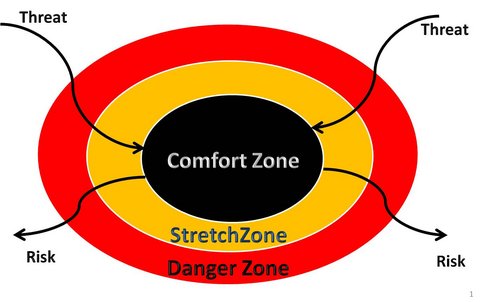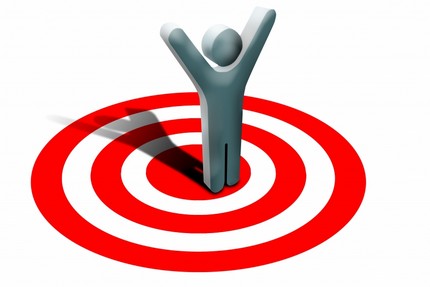
My last post started to explore the idea of being centered and offered a simple breathing technique to help you move in the direction of relaxed attention and focus.
This post will look at the concept of the comfort zone and will offer a second practical approach that can help you become more centered.
The comfort zone can be shown as the diagram top-right.
The comfort zone (CZ) is a name given to an area of psychological safety. Within our CZ we feel safe, outside we feel unsafe. A sense of real or perceived threat keeps us inside this area and the possibility of taking a risk allows us to expand it.
Immediately outside the CZ is a stretch zone – an area that we can see the possibility of entering but that also looks scary. Most types of change, new learning, new jobs or relationships all sit in this area and often contain a mix of excitement and trepidation.
Beyond the stretch zone is the danger zone. This is the area where we feel distinctly unsafe, where it is probably a bad idea (for some of us) to spend time.
As we change and grow over time the different areas shift and change, what at one time seems dangerous, will at another be part of our CZ.
The zones relate to all aspects of our life. As babies we have an innate fascination which leads us to constantly be moving into the stretch zone. As adults we vary, some of us choose to keep stretching or moving toward danger, others of us grow comfortable within what we know. What we think of as risk taking will vary, some people may take up sky diving, others may have a tough conversation with their partner, for some people leaving the house or making social connections may feel like a trip into the danger zone.
If we want to leave or expand our CZ, what is it that enables us to move into our stretch zone?
There are two facets to this, one internal and the other external.
The external is to do with other people and influences. The influences may be books, people we hear about, something that we want that drives us. It is also other people who actively help us, possibly by direct encouragement or by modelling a type of behaviour that enables us to stretch.
The internal is our own sense of resilience, competence or drive. What we know about ourselves and how we act on this knowledge. It is fostered and supported by our ability to be centered.
If we can center, we are able to look at the stretch we wish to take from a responsive place rather than a reactive one.
Being centered will help us pay attention to our emotions without being overwhelmed by them. We will be more accepting of our thoughts and feelings and then able to take greater responsibility for them and the choice we are about to make.
This choice may include not taking the stretch – but if we are centered then it is a choice, a response and not a reactive shying away from something difficult.
In my last post on centering I focussed on breathing – I suggest that you keep using this and I realise that if you are reading this post then you have successfully been breathing since reading the last one. What I mean is choosing to take an occassional deep and mindful breath and now to also pay deeper attention to your body.
How are you sitting or standing right now?
Are you relaxed or tense?
Which parts are relaxed, which are tense?
How is your posture?
Are you slumped in a chair or rigidly holding yourself in position. Are you leaning toward or away from a sore hip, shoulder or other bodily ache?
It will be easier for you to breathe if your posture is comfortable.
What I notice is that when we change our posture both our thinking and our sense of well being changes.
When your spine is straight and head, heart and gut in vertical alignment you may feel more alert and have more mental clarity.
Being centered is not a static state; it is not about sitting in a lotus position on top of a mountain bathed in sunlight. It is a choice at any time, anywhere. I move, bend, slump, switch off and get unfocussed but when I need to support myself, remembering that it is okay to sit up or stand up straighter and take a breath helps me get centered.
Our comfort zone is often a relaxed place to dwell but the following quote also fits:
“if we always do what we have always done, we will always get what we have always got”
If you want something different and that requires a move into your stretch zone, take a breath, adjust your posture, ask for help and take the step.

